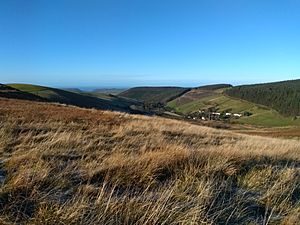Cwmsymlog facts for kids
Cwmsymlog is a short valley, sheltering a hamlet of the same name, in Ceredigion, in the west of Wales. Once an important mining area, but the mining slowly declined and finally came to an end in 1901. Now it is peaceful, open countryside with a few mining remains, scattered houses and farmland. It is also the name of a Site of Special Scientific Interest at that location.
Contents
Present
Nowadays Cwmsymlog lies hidden between the trees, surrounded by fields of sheep. The small settlement itself has a chapel and a few scattered houses. One of these has a standing stone in front of the house. The mine chimney dominates the landscape but everywhere around are traces of mining. Mining spoil piles are slowly being reclaimed by nature with gorse bushes and rare ferns. The mine chimney, nineteenth century, was restored in 2006 with extensive repairs to the top. Smaller stones were used for the top section to show the difference between the old construction and the restored part.
The Borth to Devil's Bridge to Pontrhydfendigaid Trail runs through the valley and the mountain bike trails of Bwlch Nant yr Arian skirt around the edge.
Stone Age
The presence of Palaeolithic and Mesolithic hunters is unlikely, but that of Neolithic farmers cannot entirely be ruled out.
Bronze Age
In the Bronze Age several standing stones were erected. Dating of these holy places: c.2300-800 BC. Two stones are near Pen-bont Rhydybeddau (Head of the bridge Ford of the graves), one is near the hill-fort Pen y Castell, one in front of a house called Pant y Garreg Hir (Hollow of the Long Stone) and two lie close together with the name Buwch a'r Llo (Cow and Calf) east of the last one. Near-by these paired monoliths is another one. Also built in the Bronze Age are two burial mounds (cairns/piles of stones): Garn-Wen (White Cairn) lies near Pent-bont Rhydybeddau and Carn Dolgau (Cairn of Meadow of hollow) is near Cwmerfyn (cwm/valley).
An interesting detail about the standing stone called Garreg Hir is that the stone was tumbling and eventually fell in 2017. That is why the Dutch archaeologist Lex Ritman contacted CADW in 2018 and with the cooperation and initiative of Louise Mees, regional inspector of ancient monuments and archaeology, the project started to re-erect this ancient monument. The reinstatement concerns a scheduled monument. It is legally protected. The reference name is Standing Stone c.500 m SW of Llyn Pendam, reference number CD 230.
Iron Age
In the Iron Age several hill-forts were constructed with ramparts and ditches. Banc-y-Darren (banc/hillside) lies south of Pent-bont Rhydybeddau and Pen y Castell (Head of the Castle) north of it. These defended villages are about 2000 years old.
Middle Ages and later
In medieval times and perhaps earlier Cwmsymlog (East Darren) became a mining district. In the sixteenth and seventeenth century the region is mainly known for silver mining. Smelting was at Furnace (near Talybont) and in Aberystwyth Mint was the locally minted silver. Nantyrarian (Brook of silver) is of course a logical name. Later on lead mining became important. Especially in the eighteenth and nineteenth century. Traces of these activities are everywhere: shafts like Skinner's Shaft, Taylor's Shaft and Pryse's Shaft, a tramway, leats, wheel pits, spoil tips, the reservoir Llyn Pendam (Lake of the Head of the dam) and a recently restored mine chimney.
Chapels
Today there is a chapel in the heart of the settlement, first built in 1843 and later rebuilt in 1860. This Tabernacl Welsh Baptist Chapel was established to serve the workers in the Cwmsymlog lead mines. The adjacent graveyard is the last resting place for several miners and their families. One of the more prominent graves is that of the mine captain. There is also a ruin near Pant y Garreg Hir with the name Tŷ Mawr (Big House). This ruin was the chapel built for the miners by Sir Hugh Myddleton (1560–1631).
Name Derivation
The name derivation of the name Cwmsymlog seems lost although one explanation is that it comes from 'cwm' meaning valley, ‘mwsogl’ meaning moss, together with an adjectival ending -og giving 'mossy valley'. Another possibility is 'valley of wild strawberries'
TV series
The police detective drama Y Gwyll (Hinterland) was first shown in 2013 in the Welsh version, but a year later also in English. Ceredigion and especially Aberystwyth and surroundings were the location. Besides for example Aberystwyth, Pontarfynach (Devil's Bridge) and Borth, Cwmsymlog was used for several episodes. The chapel featured in the first episode and one of the village houses was used to create a pub.
Images for kids





